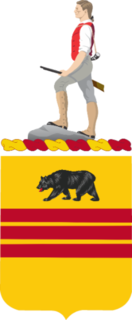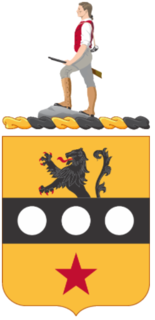Related Research Articles

The 62nd Cavalry Division was an Organized Reserve cavalry unit of the United States Army.
The 307th Cavalry Regiment was a cavalry unit of the United States Army during World War I and the interwar period. It was activated in early 1918 but broken up in the middle of the year to form new artillery units. The unit was recreated as a Virginia Organized Reserve unit during the interwar period, and was converted into a tank destroyer battalion shortly after the United States entered World War II.

The 308th Cavalry Regiment, commonly referred to as the 308th Cavalry, was a reserve regiment of the United States Army from 1917 until 1942. In September 1918, it was converted into the 65th and 66th Field Artillery, and the 22d Trench Mortar Battery. The units were stationed at Camp Kearny, California. Although demobilized in December 1918, they were re-formed and re-purposed in October 1921 as the 308th Cavalry, an element of the 62d Cavalry Division. During World War II, it was disbanded again. In 1959, the regimental headquarters was transferred to Department of the Army control.

The 305th Cavalry Regiment was a cavalry unit of the United States Army during World War I and the interwar period. It was activated in early 1918 but broken up in the middle of the year to form new artillery units. The unit was recreated as a Pennsylvania Organized Reserve unit during the interwar period, and was disbanded after the United States entered World War II.
The 153rd Cavalry Brigade was a cavalry unit of the United States Army Organized Reserve during the interwar period. Organized in 1922, the brigade spent its entire career with the 62nd Cavalry Division and was disbanded after the United States entered World War II.

The 306th Armored Cavalry Regiment was a District of Columbia-based reconnaissance unit of the United States Army Organized Reserve Corps that briefly existed after World War II. The 306th ACR later became a group before being inactivated in 1959.

The 304th Cavalry Regiment was a cavalry unit of the United States Army during World War I and the interwar period. It was activated in early 1918 but broken up in the middle of the year to form new artillery units. The unit was recreated as a New York Organized Reserve unit during the interwar period, and was converted into a tank destroyer battalion after the United States entered World War II.

The 303rd Armored Cavalry Regiment was a New York-based reconnaissance unit of the United States Army Organized Reserve Corps that briefly existed after World War II.

The 302nd Cavalry Regiment was a cavalry unit of the United States Army during World War I, the interwar period, and the Cold War. It was activated in early 1918 but broken up in the middle of the year to form new artillery units. The unit was recreated as a New Jersey Organized Reserve unit during the interwar period, and was converted into a tank destroyer battalion after the United States entered World War II. Reactivated in 1971 and 1973 in the Army Reserve, it was represented by two squadrons in the 100th Division (Training).

The 301st Cavalry Regiment was a cavalry unit of the United States Army during World War I and the interwar period. It was activated in early 1918 but broken up in the middle of the year to form new artillery units. The unit was recreated as a New York Organized Reserve unit during the interwar period, and was converted into a signal aircraft warning regiment after the United States entered World War II.

The 309th Cavalry Regiment was a cavalry unit of the United States Army during World War I and the interwar period. It was activated in early 1918 but broken up in the middle of the year to form new artillery units. The unit was recreated as a North Carolina Organized Reserve unit during the interwar period, and later moved to Georgia in the early 1930s. It was converted into a signal aircraft warning regiment after the United States entered World War II.

The 312th Cavalry Regiment was a cavalry unit of the United States Army during World War I and the interwar period. It was activated in early 1918 but broken up later that year to form new artillery units. The unit was recreated as an Oklahoma, Arizona, New Mexico, and Colorado Organized Reserve unit during the interwar period. It was converted into a signal aircraft warning regiment after the United States entered World War II.

The 315th Cavalry Regiment was a cavalry unit of the United States Army during World War I and the interwar period. It was activated in early 1918 but broken up later that year to form new artillery units. The unit was recreated as a Rhode Island, Connecticut, Vermont, and Massachusetts Organized Reserve unit during the interwar period. It was disbanded after the United States entered World War II.

The 316th Cavalry Regiment was a cavalry unit of the United States Army during the interwar period. The unit was activated as a Rhode Island, Connecticut, Vermont, and New Hampshire Organized Reserve unit during the interwar period. It was converted into a signal aircraft warning regiment after the United States entered World War II.

The 318th Cavalry Regiment was a cavalry unit of the United States Army during the interwar period. The unit was activated as an Illinois Organized Reserve unit during the interwar period. It was converted into a signal aircraft warning regiment after the United States entered World War II.

The 319th Cavalry Regiment was a cavalry unit of the United States Army during the interwar period. The unit was activated as a Michigan Organized Reserve unit during the interwar period. It was converted into a tank destroyer battalion after the United States entered World War II.

The 323rd Cavalry Regiment was a cavalry unit of the United States Army during the interwar period. The unit was activated as a California, Washington, and Oregon Organized Reserve unit during the interwar period, although it was later relocated entirely to California. It was converted into a signal aircraft warning regiment after the United States entered World War II.

The 124th Cavalry Regiment is a United States Army cavalry regiment, represented in the Texas Army National Guard by 1st Squadron, 124th Cavalry, part of the 56th Infantry Brigade Combat Team at Waco.
The 151st Cavalry Brigade was a cavalry unit of the United States Army Organized Reserve during the interwar period. Organized in 1922, the brigade spent its entire career with the 61st Cavalry Division and was disbanded after the United States entered World War II.
The 152nd Cavalry Brigade was a cavalry unit of the United States Army Organized Reserve during the interwar period. Organized in 1922, the brigade spent its entire career with the 61st Cavalry Division and was disbanded after the United States entered World War II.
References
Citations
Bibliography
- Clay, Steven E. (2010). US Army Order of Battle 1919–1941 (PDF). 2. Fort Leavenworth, Kansas: Combat Studies Institute Press. ISBN 9781780399171.